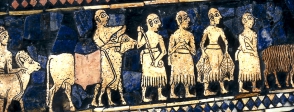The Standard is very rich in details. The first activities focus on familiarising the students with the different characters.
Show students a close-up image of the war side. What kinds of weapon can they spot? How are the soldiers protected? What sorts of fighting methods are being used? Do they think this army was well-organised? Compare images of other ancient soldiers such as Egyptians.
Explain to students that the Standard shows that different types of people in an ancient city: soldier, farmer, musician, king. Show students close-up images of the Standard, and ask them to identify the different characters and what they are doing.
Give groups of students a large print-out of one of the levels on the Standard of Ur. Based on what they now know about individuals and about the whole sides of the Standard, what might the different people in the level be saying to each other? Ask students to add bubble captions to the level they have been given.
Ask students to make a list of things that represent power and wealth. Explain to students that there are many things on the ‘peace’ and ‘war’ side of the Standard which show the power and wealth of the ruler. Ask them to identify symbols of wealth on the ‘peace-side’, how they can tell who the ruler is and which people are rich and which less well-off. Then ask them how the ‘war-side’ demonstrates the power of the ruler.
In groups, let students create their own version of the Standard of Ur. They can draw two contrasting scenes depicting home vs. school, school vs. holiday, winter activities vs. summer activities, indoor activities vs. outdoor activities.
Arrange students in two groups, and ask them to work together to create a school version of the Standard of Ur. One group could create a playground scene while the other group could work on a classroom scene.
Looking for details can lead into considering the raw materials and manufacturing processes that must have existed in ancient Ur.
Download and print the images of the cup, rein ring, lyre and fleece skirt in For the classroom. Ask the students to find these objects depicted in the scenes on the Standard. How does the Standard help us learn about how these objects were used? Discuss reasons why only three of the four objects have survived. Search for other objects on the Standard; consider what they were probably made of in real life, for example, a chair - made of wood; reins – made of leather; spear point – made of metal.
What jobs did people do in ancient Ur? Once students have looked in detail at the many objects, clothing and furniture shown on the Standard, they could make a list of all the jobs that people needed to do. Encourage them to think beyond the obvious: a maker of reins would need animal skins to be cleaned and then tanned to make leather; a potter would need clay to be dug and cleaned and also the kiln would need to be stoked to fire the pots.
Do some map work to locate the places that the lapis lazuli, red stones and white shell came from. How do the students think these materials reached Ur? Investigate what may have gone the other way to pay for the precious materials.
You could also look at dining across cultures in history.
Focus on the dining scene on the Standard. Identify all the people (host, guests, servants, entertainers) and what they are doing. Compare the other images of dining in A bigger picture. Discuss and compare the students’ experience of family meals or other events involving dining.


